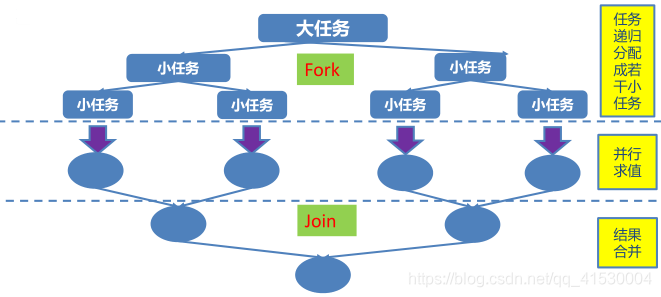线程按序交替
- 例题:编写一个程序,开启 3 个线程,这三个线程的 ID 分别为A、B、C,每个线程将自己的 ID 在屏幕上打印 10 遍,要求输出的结果必须按顺序显示。如:ABCABCABC…… 依次递归,代码如下:
public static void main(String[] args) {
AlternateDemo ad = new AlternateDemo();
new Thread(new Runnable() {
@Override
public void run() {
for (int i = 1; i < 11; i++) {
ad.loopA(i);
}
}
}, "A").start();
new Thread(new Runnable() {
@Override
public void run() {
for (int i = 1; i < 11; i++) {
ad.loopB(i);
}
}
}, "B").start();
new Thread(new Runnable() {
@Override
public void run() {
for (int i = 1; i < 11; i++) {
ad.loopC(i);
}
}
}, "C").start();
}
}
class AlternateDemo {
private int number = 1;//当前正在执行线程的标记
private Lock lock = new ReentrantLock();
private Condition condition1 = lock.newCondition();
private Condition condition2 = lock.newCondition();
private Condition condition3 = lock.newCondition();
/**
* @param totalLoop 循环第几轮
*/
public void loopA(int totalLoop) {
lock.lock();
try {
//1,判断
if (number != 1) {
condition1.await();
}
//2,打印
for (int i = 1; i < 2; i++) {
System.out.println(Thread.currentThread().getName() + "\t" + i + "\t" + totalLoop);
}
//3,唤醒
number = 2;
condition2.signal();
} catch (InterruptedException e) {
e.printStackTrace();
} finally {
lock.unlock();
}
}
public void loopB(int totalLoop) {
lock.lock();
try {
//1,判断
if (number != 2) {
condition2.await();
}
//2,打印
for (int i = 1; i < 2; i++) {
System.out.println(Thread.currentThread().getName() + "\t" + i + "\t" + totalLoop);
}
//3,唤醒
number = 3;
condition3.signal();
} catch (InterruptedException e) {
e.printStackTrace();
} finally {
lock.unlock();
}
}
public void loopC(int totalLoop) {
lock.lock();
try {
//1,判断
if (number != 3) {
condition3.await();
}
//2,打印
for (int i = 1; i < 2; i++) {
System.out.println(Thread.currentThread().getName() + "\t" + i + "\t" + totalLoop);
}
//3,唤醒
number = 1;
condition1.signal();
} catch (InterruptedException e) {
e.printStackTrace();
} finally {
lock.unlock();
}
}
}
ReadWriteLock读写锁
- ReadWriteLock 维护了一对相关的锁,一个用于只读操作,另一个用于写入操作。只要没有 writer,读取锁可以由多个 reader 线程同时保持。写入锁是独占的。
//写写要互斥,读读不需要
public static void main(String[] args) {
ReadWriteLockDemo rw = new ReadWriteLockDemo();
new Thread(new Runnable() {
@Override
public void run() {
rw.set((int) (Math.random()*101));
}
},"Write").start();
for (int i = 0; i < 100; i++) {
new Thread(new Runnable() {
@Override
public void run() {
rw.get();
}
},"Read").start();
}
}
}
class ReadWriteLockDemo {
private int number = 0;
private ReadWriteLock lock = new ReentrantReadWriteLock();
//读
public void get() {
lock.readLock().lock();//上锁
try {
System.out.println(Thread.currentThread().getName() + ":" + number);
} finally {
lock.readLock().unlock();
}
}
//写
public void set(int number) {
lock.writeLock().lock();
try {
System.out.println(Thread.currentThread().getName());
this.number = number;
} finally {
lock.writeLock().unlock();
}
}
}
线程八锁
- 1,两个普通同步方法,两个线程,标准打印,打印 //one two
- 2,新增Thread.sleep()给getOne(),打印 //one two
- 3,新增普通方法getThree,打印 //three one two
- 4,两个普通的同步方法,两个Number对象,打印 //two one
- 5,修改getOne()为静态同步方法,打印 //two one
- 6,修改两个方法均为静态同步方法,一个Number对象,打印 //one two
- 7,一个静态同步方法,一个非静态同步方法,两个Number对象,打印//two one
- 8,两个静态同步方法,两个Number对象,打印//one two
线程八锁的关键:
1,非静态方法的锁默认为this,静态方法的锁为对呀的Class实例
2,某一时刻,只能有一个线程持有锁,无论几个方法。
代码如下:
public class JucTest {
public static void main(String[] args) {
Number number = new Number();
Number number1 = new Number();
new Thread(new Runnable() {
@Override
public void run() {
number.getOne();
}
}).start();
new Thread(new Runnable() {
@Override
public void run() {
number1.getTwo();
}
}).start();
// new Thread(new Runnable() {
// @Override
// public void run() {
// number.getThree();
// }
// }).start();
}
}
class Number{
public static synchronized void getOne(){
try {
Thread.sleep(3000);
} catch (InterruptedException e) {
}
System.out.println("one");
}
public synchronized void getTwo(){
System.out.println("two");
}
public void getThree(){
System.out.println("three");
}
}
线程池
-
概念:提供了一个线程队列,队列中保存着所有等待状态的线程,避免了创建与销毁额外开销,提高了响应的速度。
-
线程池的体系结构:
java.util.concurrent.Executor:负责线程的使用与调度的根接口
ExecutorService子接口:线程池的主要接口
ThreadPoolExecutor: 线程池的实现类
ScheduledExceutorService子接口:负责线程的调度
ScheduledThreadPoolExecutor:继承ThreadPoolExector,实现ScheduledExecutorService
工具类:Executors
ExecutorService newFixedThreadPool():创建固定大小的线程池
ExecutorService newCachedThreadPool():缓存线程池,线程池的数量不固定,可以根据需求自动的更改数量
ExecutorService newSingleThreadExecutor():创建单个线程池。线程池中只有一个线程
ScheduledExecutorService newScheduledThreadPool():创建固定大小的线程,可以延迟或定时的执行任务
线程池的代码使用如下:
public static void main(String[] args) throws Exception {
//1,创建线程池
ExecutorService pool = Executors.newFixedThreadPool(5);
Future<Integer> future = pool.submit(new Callable<Integer>() {
@Override
public Integer call() throws Exception {
int sum = 0;
for (int i = 0; i <= 100; i++) {
sum += i;
}
return sum;
}
});
System.out.println(future.get());
/* ThreadPoolDemo td = new ThreadPoolDemo();
//2,为线程池中的线程分配任务
for (int i = 0; i < 10; i++) {
pool.submit(td);
}*/
//3,关闭线程池
pool.shutdown();
}
}
class ThreadPoolDemo implements Runnable{
private int i =0;
@Override
public void run() {
while (i<=100){
System.out.println(Thread.currentThread().getName()+":"+i++);
}
}
}
线程调度
- 一个 ExecutorService,可安排在给定的延迟后运行或定期执行的命令。代码如下:
public static void main(String[] args) throws Exception {
ScheduledExecutorService pool = Executors.newScheduledThreadPool(5);
for (int i = 0; i < 5; i++) {
Future<Integer> future = pool.schedule(new Callable<Integer>() {
@Override
public Integer call() throws Exception {
int num = new Random().nextInt(100);
System.out.println(Thread.currentThread().getName() + ":" + num);
return num;
}
}, 2, TimeUnit.SECONDS);
System.out.println(future.get());
}
pool.shutdown();
}
ForkJoinPool分支/合并框架 工作窃取
- Fork/Join 框架:就是在必要的情况下,将一个大任务,进行拆分(fork)成若干个小任务(拆到不可再拆时),再将一个个的小任务运算的结果进行 join 汇总

- 采用 “工作窃取”模式(work-stealing):当执行新的任务时它可以将其拆分分成更小的任务执行,并将小任务加到线程队列中,然后再从一个随机线程的队列中偷一个并把它放在自己的队
列中。
public static void main(String[] args) {
Instant start = Instant.now();
ForkJoinPool pool = new ForkJoinPool();
ForkJoinTask<Long> task = new ForkJoinSumCalculate(0L, 1000000000L);
Long sum = pool.invoke(task);
System.out.println(sum);
Instant end = Instant.now();
System.out.println("消耗时间为" + Duration.between(start, end).toMillis());//10829
}
//for循环测试
@Test
public void testFor() {
Instant start = Instant.now();
Long sum = 0L;
for (Long i = 0L; i <= 1000000000L; i++) {
sum += 1;
}
System.out.println(sum);
Instant end = Instant.now();
System.out.println("消耗时间为" + Duration.between(start, end).toMillis());//11471
}
//java8测试
@Test
public void testJava8() {
Instant start = Instant.now();
Long sum = LongStream.rangeClosed(0L, 1000000000L).parallel().reduce(0L, Long::sum);
System.out.println(sum);
Instant end = Instant.now();
System.out.println("消耗时间为" + Duration.between(start, end).toMillis());//756
}
}
class ForkJoinSumCalculate extends RecursiveTask<Long> {
private Long start;
private Long end;
private static final Long THRSHOLD = 10000L;
public ForkJoinSumCalculate(Long start, Long end) {
this.start = start;
this.end = end;
}
@Override
protected Long compute() {
Long length = end - start;
if (length <= THRSHOLD) {
Long sum = 0L;
for (Long i = start; i <= end; i++) {
sum += i;
}
return sum;
} else {
Long middle = (start + end) / 2;
ForkJoinSumCalculate left = new ForkJoinSumCalculate(start, middle);
left.fork();//进行拆分,同时压入线程队列
ForkJoinSumCalculate right = new ForkJoinSumCalculate(middle + 1, end);
right.fork();
return left.join() + right.join();
}
}
}
